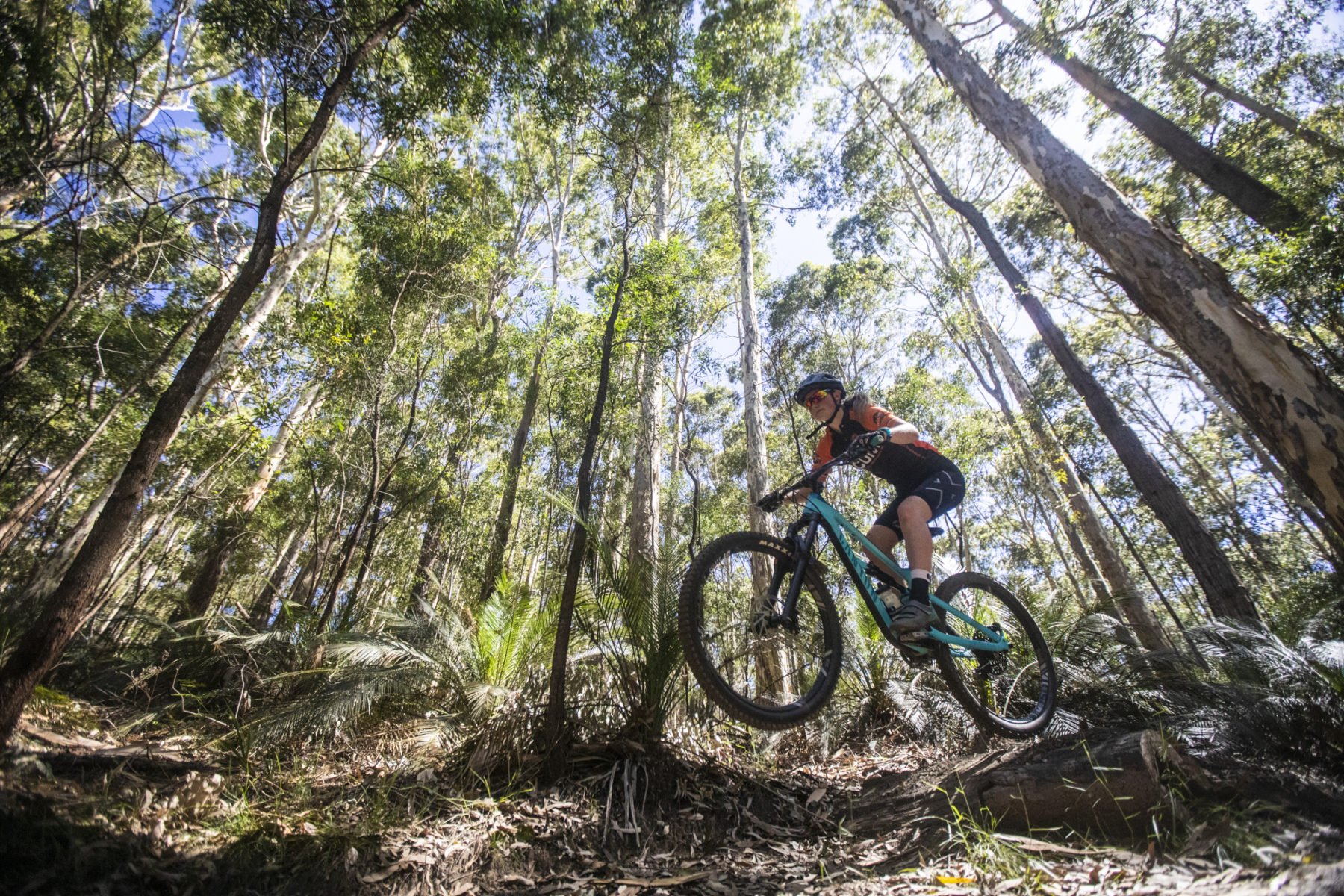The smoke swirls around Matt Simms, a proud Wandi Wandian man, as he performs a welcome to country ceremony. Aus Geo’s Liz Ginis, myself and some other visitors have joined a Djiriba Waagura (‘Two Crows’, in the Yuin Nation’s Dhurga language) cultural tour with Matt and Raymond Timbery. We’re gathered around Matt and the small fire at Huskisson’s Jervis Bay Maritime Museum, and listened to Raymond explain the significance of the welcome (more on that later) before taking turns immersing in the smoke, enjoying one of what became many elemental connections to the beautiful Shoalhaven region of New South Wales.
For me, it was part of what ended up being – over a week in the Shoalhaven – the ultimate re-boot. Global pandemic, crowded city, busy home-life and work disappear over the five days we spend exploring this area, giving myself and Liz (both coincidentally ‘country kids’ with that unique connection to regional Australia) that immemorable reminder that nature will always trump industry – and it’s a hell of a lot more fun, too.
Southern belle
The Shoalhaven region covers from pretty Shoalhaven Heads in the north, across to the rugged ramparts of the Morton escarpment near Kangaroo Valley and North Durras to the south. It is, really, the epitome of an adventure playground, with more than 100 beaches, some mighty waterways (the Shoalhaven and Clyde rivers), an even mightier Jervis Bay, and 70 per cent of its total area comprising national parks and state forests. We are exploring the popular Jervis Bay and surrounds (encompassing Huskisson, Vincentia, Boodee NP and more) and the south-eastern part of Morton National Park on this week-long adventure, with the seemingly over-sized promise of hiking, paddling, climbing, mountain biking and cultural enrichment ahead of us.
As it turned out, that word ‘over-sized’ doesn’t come close: that promise was more than fulfilled, with this writer reaching the end of the week exhilarated and exhausted but having only really scraped the surface in terms of the sheer amount of adventure and exploration the Shoalhaven offers visitors. It was a sacrifice we were more than happy to make again…
Straight to the edge
We, literally, hit the road running on day one, tackling a short drive from our accommodation at Huskisson north around Jervis Bay to the pretty village of Currarong, on the northern side of the Beecroft Peninsula. Here, we find what has to be one of the best short bushwalks in the region: Abrahams Bosom Walking Track and the roughly one-hour-return sojourn along the Wreck/Coomies walk, passing coastal heath and numerous viewpoints back across the coastline, to the natural wonder that is Gosang’s Tunnel.
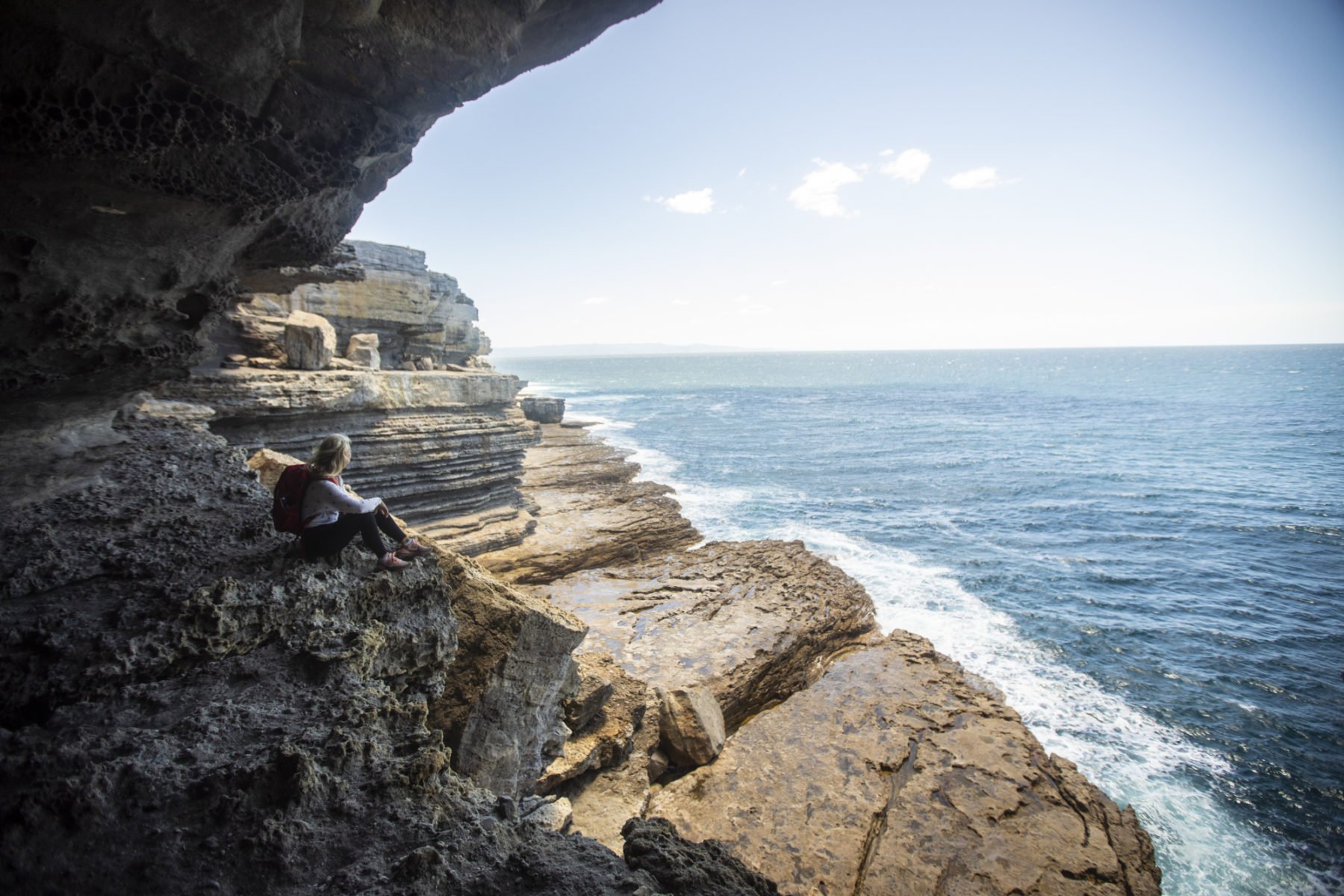
This tunnel bores through the headland for around 20 metres – and requires a slightly bent-over shuffle to negotiate – but the location and view at the other end make that effort more than worth it. Coming out of the tunnel you’re deposited on the edge of some of the famous sea cliffs of the Shoalhaven, overlooking the thundering Tasman Sea as it pounds against the rocks below. The walk – and viewpoint – is a microcosm of the region’s natural wonder and the best bang for your bucks for visitors
We amble around the large rock-shelf that juts east from the tunnel entrance on the cliff-side for a while, enjoying the view and the fact we are so fortunate to have it all to ourselves. It’s with some reluctance that we re-enter the tunnel for the return journey back to the carpark, but a reluctance muted somewhat by what we have coming up next…
Two wheels, trails galore and the energy of youth
The Shoalhaven is made for bicycles. I decide that not more than a few minutes after we arrive on our first day and spot the excellent multi-use path linking Huskisson to Vincentia. That impression of two-wheeled friendliness is amplified after we arrive at Superbowl, one of the many mountain bike trails in the area, to meet Nick Smee, President of South Coast United Mountainbikers. SCUM, as the club is known (yep, I agree, it’s a brilliant acronym) was established in 2004 and currently has around 170 members. Joining Nick to show us around is Grant Turner and a bunch of the club’s Academy riders, including Academy coach Lynne Vaughan.

Superbowl is one of the great MTB trails in the region. 
Joining the locals for a ride on the trails here is a must-do for any visiting MTBers.
The 8km loop of Superbowl is one of three MTB trails (the other two main MTB trails are Coondoo, at 11km, and Butterfly, at6km) in the Callalla Bay area (accessed off Forest Road, the main route to Callalla Bay from the Princes Highway). For those looking for MTB trails closer to Nowra, Cabbage Tree Lane – a 6km loop – offers a brilliant beginner/kids’ experience just west of the town. The club, with NSW Forestry, manages these trails.
Superbowl is just magic, with its mix of undulating singletrack, berms and drop-offs, flowing between big trees and lush green ferns. And the kids from the Academy (a near-equal mix of male and female riders) showcase it at its best, with skills that are a credit to the Academy program. No matter how much ‘faster’ I ask these young guns to go, they just keep getting quicker again; big berms, drop-offs and jumps are confidently tackled each and every time at increasing speeds. It’s impressive stuff and a fitting result of Lynne and the club’s focus on not only the riding, but the social side of MTB.
“I am constantly proud of how focused and dedicated they are to their sport and they always bring 100 per cent to training,” Lynn says. “They are forming lifelong friendships with a mutual love of bike riding. Their achievements are a credit to their hard work but it’s not about winning or being first (a nice side effect) but the journey they have along the way – learning independence, resilience, making friends, having fun and building lifelong wellbeing strategies.” It’s hard not to agree with that.
It’s hard not to see the appeal of a weekend road-trip down here to this part of the Shoalhaven just to sample these trails – something that Nick reckons is already popular with visitors from Sydney and Canberra – and it’d be an easy task to convince the family to tag along, too. here just to sample these trails – something that Nick reckons is already popular with visitors from Sydney and Canberra – and it’d be an easy task to convince the family to tag along, too.
“It’s really well known, this area, now,” he says. “Each weekend we’ll always have cars parked here and out at Butterfly. For people who don’t want to ride, they’re in one of the accommodations around here and they can spend a weekend at the beach.
“Those that ride, can get out and have a good ride. Ride in the morning, go and surf in the afternoon; it’s a good weekend away.” Those words were no sooner out of Nick’s mouth then I was mentally jotting in a date for a return.
Water world
The sun is teasing us through the dawn clouds at Iluka Beach, turning the early morning light blue, then purple, then later gold as Jervis Bay Kayaks guide Terry Davis, Liz and I sort out our sea kayaks on the shore. We’re heading out for an exploratory paddle across this southern part of Jervis Bay, toward Bowen Island, a small but pristine bump that sits just off the edge of the Bherwerre Peninsula, the bay’s tree-crowded, beach-lined southern ‘heads’ – a stark contrast to the steep sea cliffs of Point Perpendicular on the bay’s northern heads.
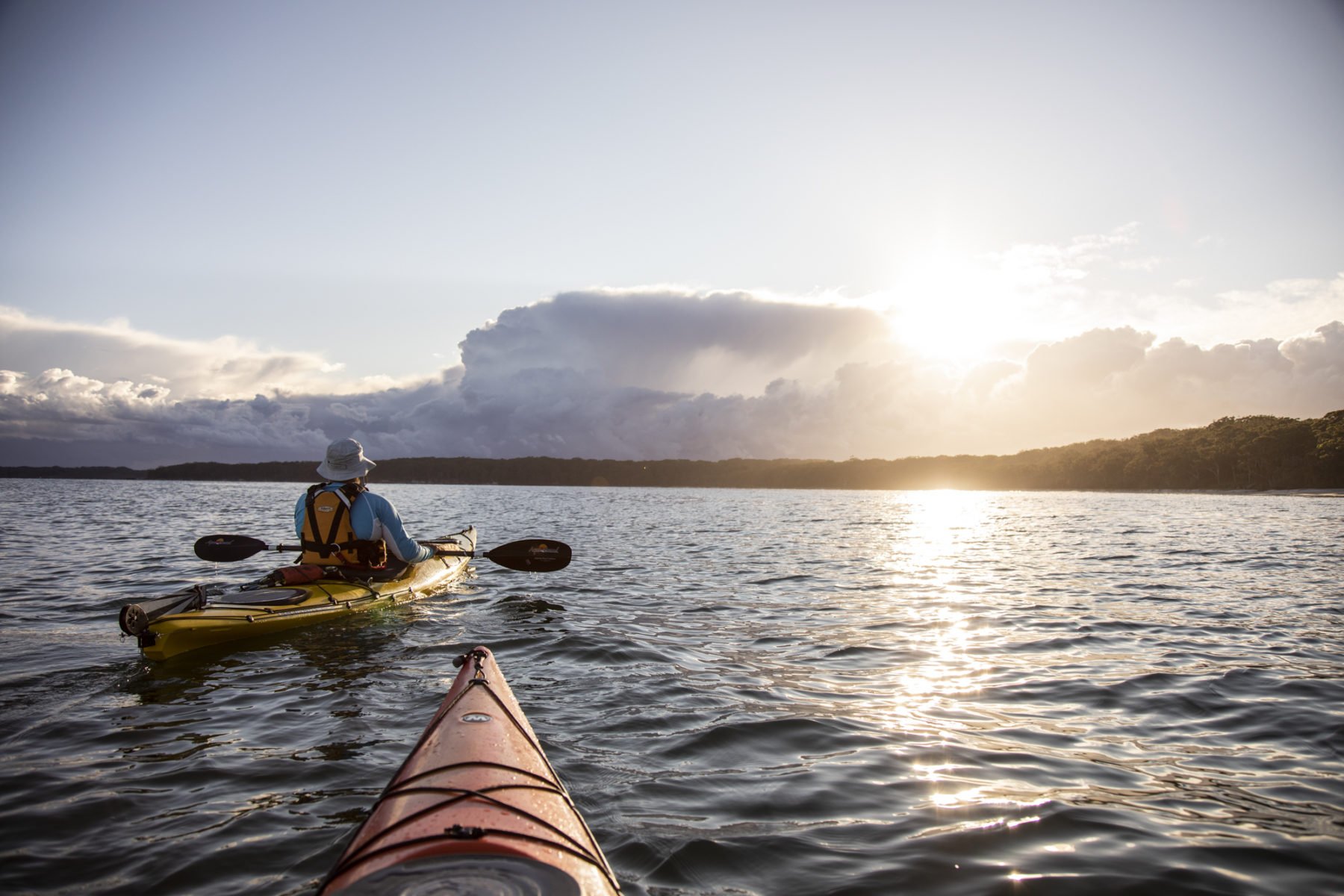
Water, to me as a south coast boy, has always been a source of connection to where I grew up, and this paddle magnifies that. It’s super-early as there’s no wind thanks to the shelter provided by the peninsula’s landmass, and the bay’s famous white sand and that muted morning light fire up the water into a glassy turquoise mirror.
When we reach the north-easterly curve of Bherwerre Peninsula, past Murray Beach Boat Ramp, we are in less sheltered open water and it is brilliant – and perfectly timed with the sun now fully risen and turning the rocky outcrops on the southern end of Bowen Island a rich gold, as the ocean’s wave crash against them. The wind hits us here a bit, but paddling through the slightly choppy water, if anything, brings a closer connection to this magic location; nothing beats that cliché of wind, salt and water in your face when you’re on the water to describe that feeling of total immersion in your environment.
We pause and shelter behind the island for a little while, hoping to spot some of the island’s resident penguins, but they’re nowhere to be seen this morning; most likely they are out foraging for food. That missed wildlife opportunity is soon forgotten, though, as we head back toward Iluka Beach.
Wet and wild
I paddle ahead to photograph Liz and Terry as we re-cross the open water and, in between getting to where I need to be, and turning the kayak around, I miss the turtle that Terry and Liz spot. I do, however, have a nice, up-close-and-personal encounter with a surprised seal that bobs up in front of my kayak, emitting a short bark of surprise before diving down again. It’s another of the many reminders that, in this still-wild bay, we’re just short-term passers-by – but more than happy to be ‘just’ that. This is something Jervis Bay Kayaks owners Bart and Sarah Malecki know after a number of years paddling here, with Bart mentioning numerous whale encounters, and one amazing experience with the bay’s resident dolphins.
“Probably the best experience I’ve had; I’ve been surfing my kayak on Cave Beach with no one around – just me and the kayak, little bit of surf – and I was joined by a pod of a dozen dolphins,” he laughs. “They were literally surfing waves right next to me for an hour.
“I’d surf it in, punch back out in my kayak, they’d come back and sort-of frolic around me. And when I caught another wave, they’d catch it with me. We did that together for an hour; me and a dozen dolphins having a surf at Cave Beach with no other human in sight for an hour.”
After the brief seal and turtle catch-up, we keep paddling back toward Iluka Beach. Unsurprisingly, we take our time on this return leg; that connection is strong between the bay’s water and us. The wind has come up a bit more, but Terry tucks us in close to shore and we pass the pretty natural rock formation of Hole in The Wall (also accessible via a walking track from Jervis Bay Road) and a few early beachgoers enjoying the morning. As Iluka Beach looms closer, Terry convinces us (well, it didn’t take much) to land briefly on a section of beach further around the bay. He, like us, doesn’t seem in any hurry to re-join civilization, even though in this part of the world, even that is no hard task. After a wander in the sand – and more ogling at that brilliant water-colour from shore – we jump back in for a short push back to our put-in point.
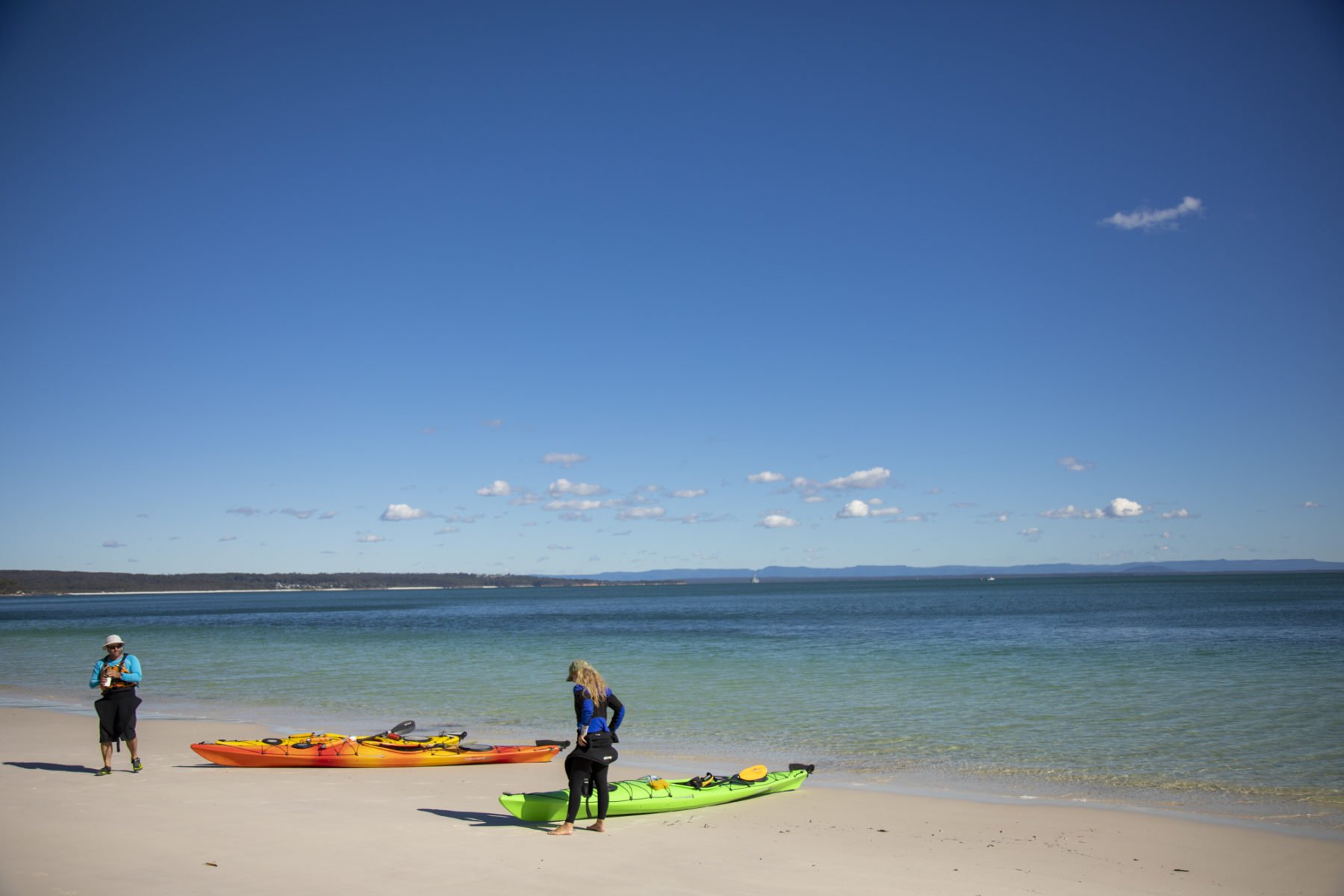
All too soon, it’s over, well, sort of… For this latent sea kayaker, this trip’s combo of pristine marine environment, a brilliant paddling route and knowledgeable guide has reawakened the passion for ocean-borne journeys. It’s easy to see why Bart rates it as the “quintessential Jervis Bay experience” for paddlers of all skill levels.
More Shoalhaven water fun
The oft-calm waters found in different parts of Jervis Bay, plus pretty Currambene Creek, allow Stand Up Paddle-boarding to thrive. This popular outdoor activity is also very easy to learn, confirmed by the pretty awesome guarantee from Huskisson’s SUP with George, run by George Payne, that he’ll have you up on a board, paddling and enjoying the local marine environment, on your first try.
For George, opening up a SUP hire and guide business (he also hires out boats and fishing gear, kayaks and bikes, and grew up working on the local tour boats) in the Shoalhaven region was a no-brainer, he tells me when I catch up with him in the afternoon after the kayaking. Running the business combines his love for the local marine environment and 10 years of SUP experience (he’s Academy of Surfing Instructors SUP qualified), with the chance to showcase it at a leisurely pace. The guided SUP tours are usually around 1.5 hours on the water the Currambene Creek tours cover around 3km of paddling, at a nice leisurely pace. It’s the variety of conditions and environments that mean George can offer a number of locations and tours, as he explains.
“I’ve got about eight different tours,” he explains. “All of which are very weather dependent; we get different conditions on many different days. My common one is we operate in Currambene Creek, because you can normally escape that northerly summer wind, which is nice. And yes, we can go out into the bay, as well.”
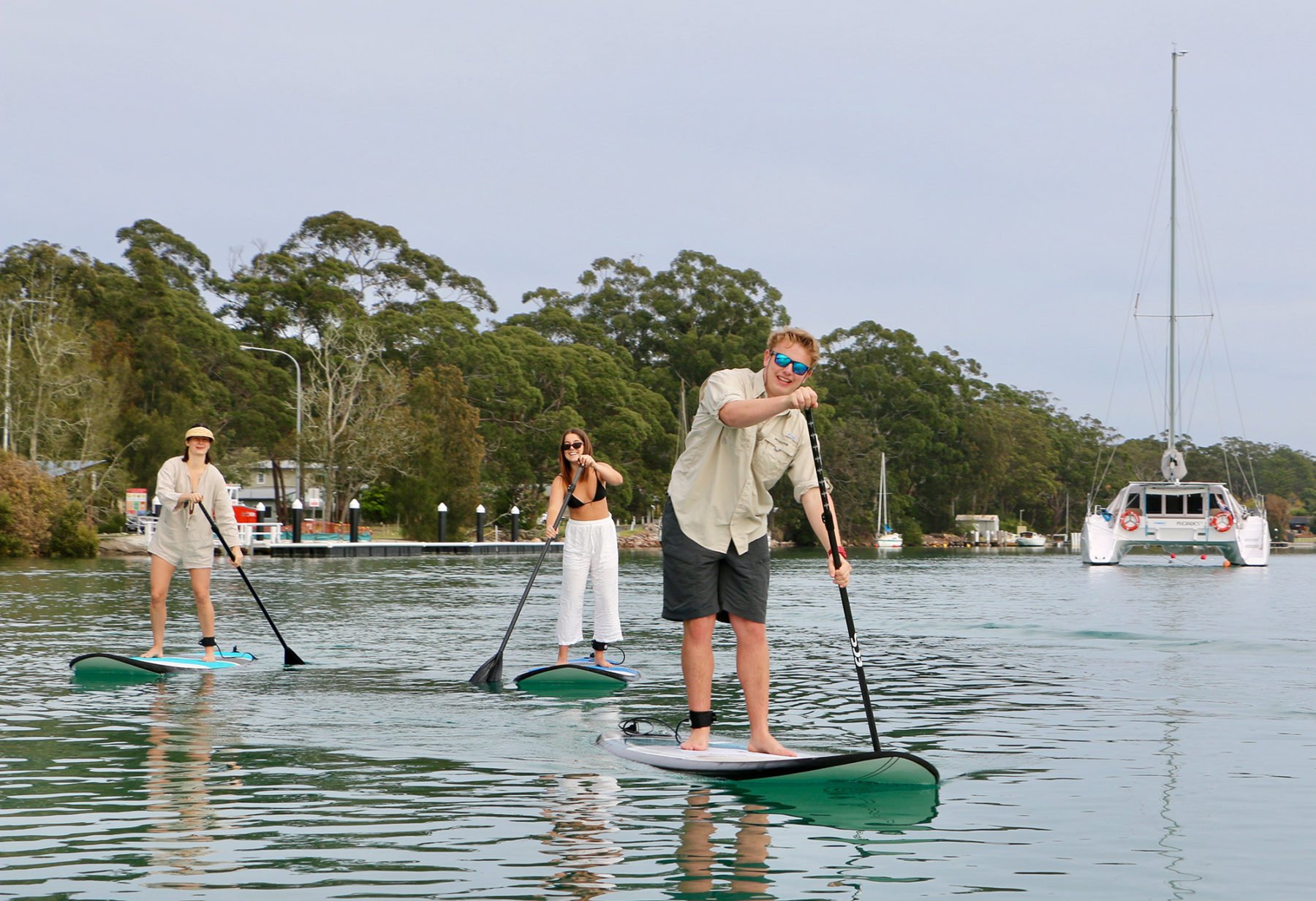
A highlight for George when guiding and teaching future SUP paddlers – and confirmation he really does have one of the best jobs in the world – is the chance to spot the abundant marine life, with some of his launch sites for creek trips ideal for spotting huge stingrays – “the size of car bonnets; like, they’re huge” – through to giant flathead fish up to one metre in length.
After leaving George I reflect on the conversations I have had with both him and Bart regarding the bay, its surrounds, and the immense appeal of its environment. Being immersed in the Shoalhaven’s marine wonderland has enabled a stronger-than-imagined reconnection with my south coast roots and made me realise what I always scoffed at as an ignorant city-based ideal of a ‘seachange’ is the reality here – and one worth experiencing, even if only for a few days.
The closest connection in the Shoalhaven
It is the following morning – another Shoalhaven belter of the sun rising slowly over the bay – that we catch up with the lads from Djiriba Waagura at the Jervis Bay Maritime Museum. Matt, Raymond, and Raymond’s younger brother Bobby sit down for a chat and it’s not long before us ‘south coast boys’ figure out we’ve got a connection through mutual friends from further down the coast (Moruya, Batemans Bay, Narooma, Eden) where I grew up. It’s a funny twenty minutes that proves the world really is small. Speaking of connections, and one that is incredibly strong; Raymond and Matt’s unique – and ancient – connection comes through their family group’s heritage (they originated from La Perouse) as artefact makers, and it is something the two are incredibly proud to continue.
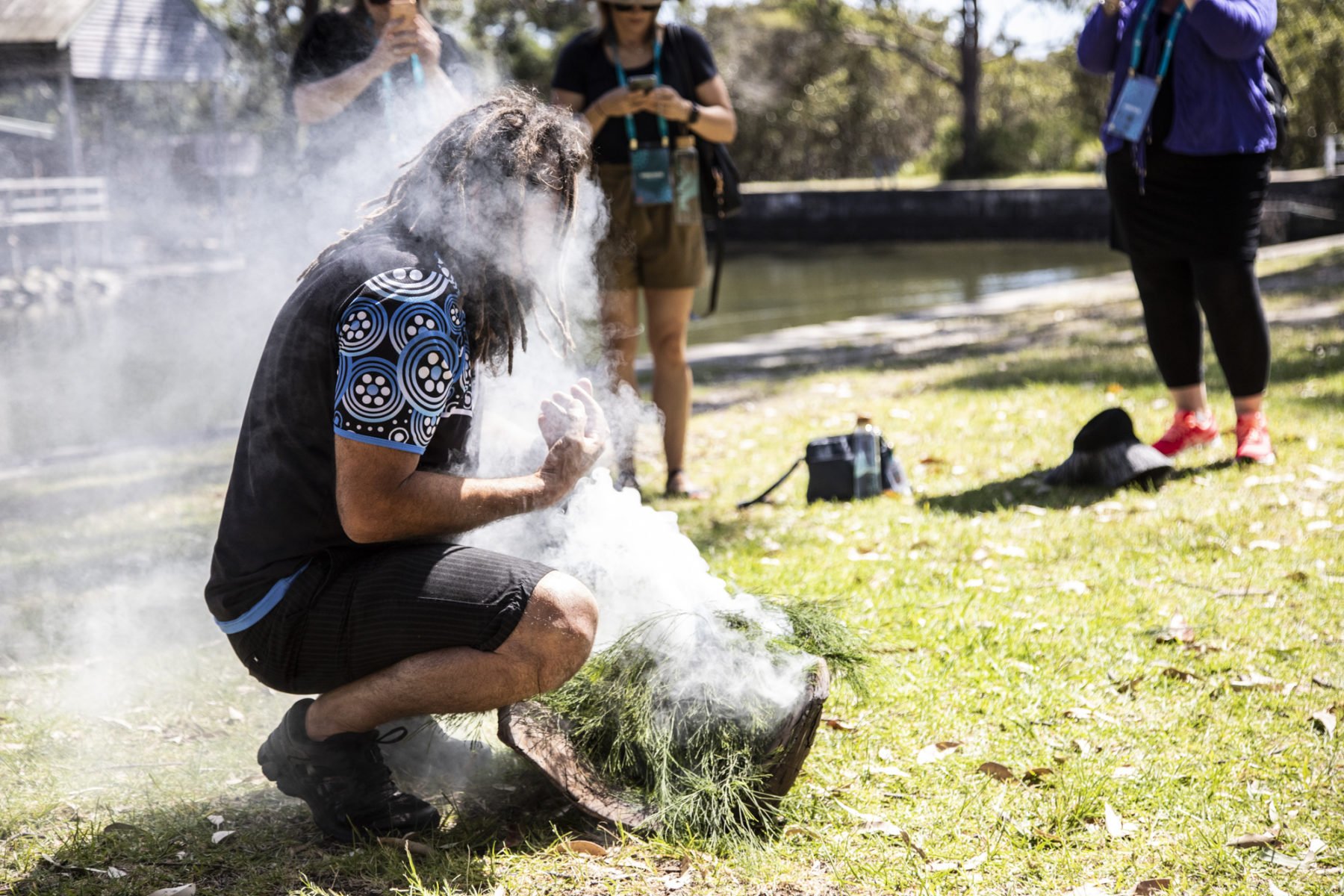
The welcome to country ceremony is an enriching experience, with Raymond explaining the significance of it to all of us, in terms of it allowing us to connect with our ancestors via a gateway through the smoke to help dispel any sadness or anger we may be holding inside. The term ‘spiritual’ gets overused in today’s world, but in the case of the smoking ceremony, it truly does apply.
The walk is led by Raymond and he takes us through a winding path that covers off a variety of different plants, their significance to his culture, and their uses today, referring a number of times back to what their elders (from the nearby Wreck Bay community) have taught them. Later, toward the end of our walk, we encounter Matt, who has a special treat for us in the form of a native sarsaparilla drink to taste.
“For us here on the coast; that’s our most important medicine.” Matt says. “What it does, it’s a boost to your immune system, to the point where, if you’ve got an infection, it will keep away the common cold… It’s a super-medicine.”
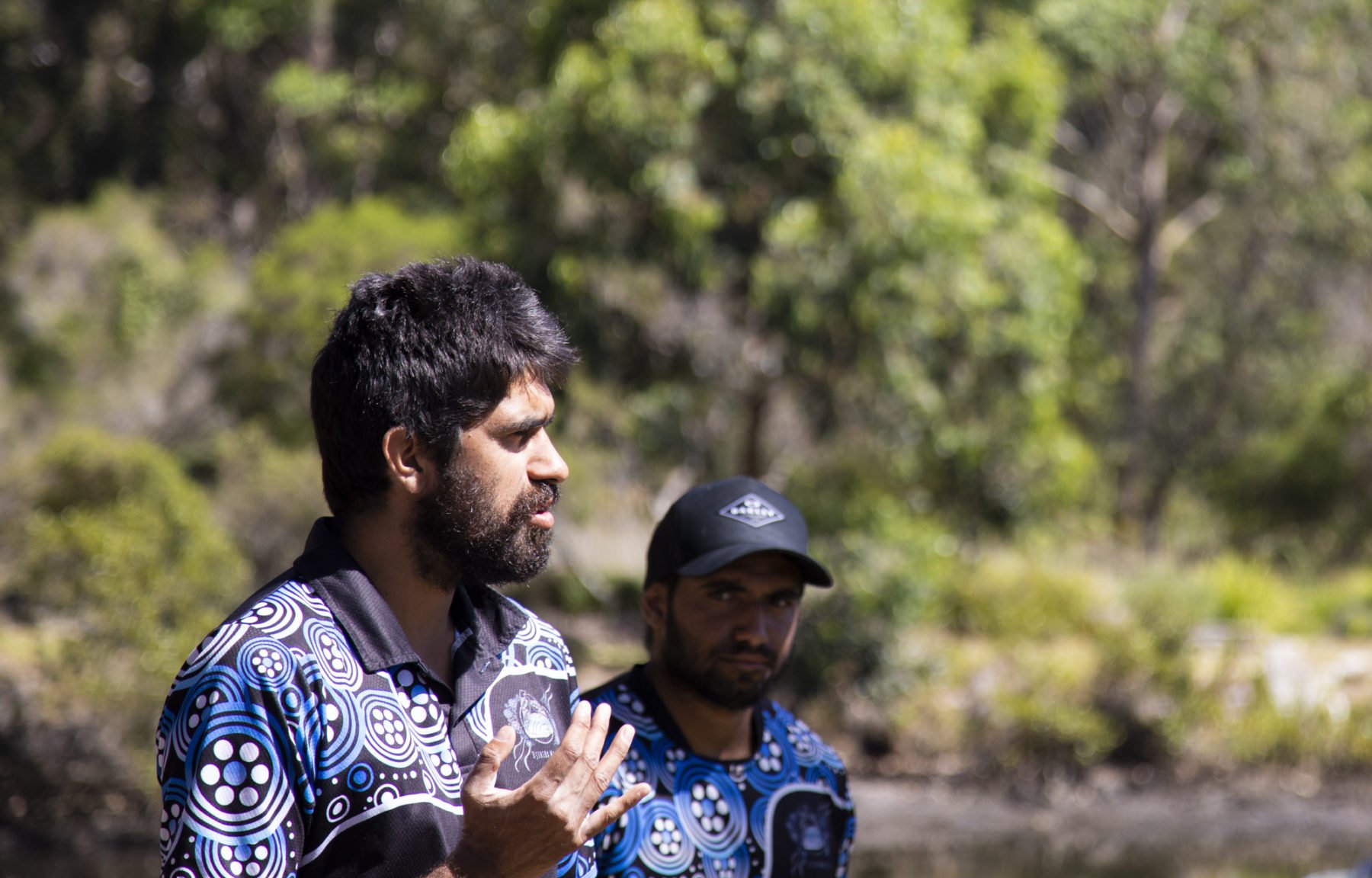
The walk is enriching and it’s a bit of a bummer to say goodbye to the lads once we return to near where we started, close to a colourful cabin that is associated with Raymond’s grandfather, Uncle Laddie Timbery, who was a highly respected elder and a rich source of knowledge for Raymond. For another source of cultural understanding Djiriba Waagura runs on-country cultural camps, as Matt explains.
“We run on-country cultural camps where we invite people on the country and we invite them into our world,” he says. “When they come and stay with us, we welcome them as family, and they learn some of our cultural practices and we collect abalone. All the different shellfish, kippies, Sydney cockles – we call them ‘bimblers’ in our language.
“We take young people on expeditions through the bush where we’re following the track the old people did – our song lines. And we’re able to take them to all the sacred sites where our old people have been for a long time…”
Climb a river, walk a comeback story
Robert Crow, of Climb Nowra, is the epitome of a climber. Lean, strong and with a calm demeanour that always seems, to people who don’t understand the appeal of climbing, to be the polar opposite mind-set to what they think must be required to scale vertical cliffs and snowclad mountains. It is this calm demeanour, however, that is most welcome today as he stands with a slightly nervous Liz and starts the process of introducing her to the essentials of climbing, in what is a very unique climb location, right above the beautiful Shoalhaven River.

Yep, for those who think of “the Shoalhaven” and “climbing”, invariably the awesome cliffs at Point Perpendicular spring to mind – and with good reason: this part of the south coast is a climbing Mecca, offering exposed routes over the ocean, and views back across Jervis Bay. What is less well-known to the larger climbing public is the fantastic climbing on offer along the banks of the Shoalhaven River, just inland from the Nowra bridge.
We first met Rob at his place and chatted about climbing philosophies and locations around the world before he sorted Liz out with her gear and we set off to start her fast-tracked introduction to climbing, mindful of Rob’s philosophy of climb tuition, and what he has in store for Liz this afternoon.
“I want to take people who really feel it and care for it… and understand the value of it and build the system,” he affirms. “So, I would start from scratch and build the system and have that person belaying me before the end of the day.”
And that’s how it pans out. The location, on the river’s southern side, is a cliff-wall with a number of bolted routes, and a view over a flat embankment below (complete with family of grazing roos), that looks pretty formidable at first glance. But lots of quiet assurance and guidance from Rob sees Liz scaling her first climb route with aplomb, taking her time, listening to Rob’s advice as he belays her, and topping out above the tree-line with what must be a cracking view across the river valley.
Then, the pair accomplish the second part of his system-building chat; Liz jumps on belay and Rob scampers up the same route with all the finesse garnered from decades of climbing experience. Liz is pumped after the climb and we’re both gob-smacked when Rob starts listing the numerous other climb routes along both sides of the river. This one is my favourite though, as Rob says that instead of looping from North Nowra, across the bridge and through the back of town to this climb, you could, instead, paddle a canoe across from the northern side, tie-up below, and be at the crag in 15 minutes – epic!).
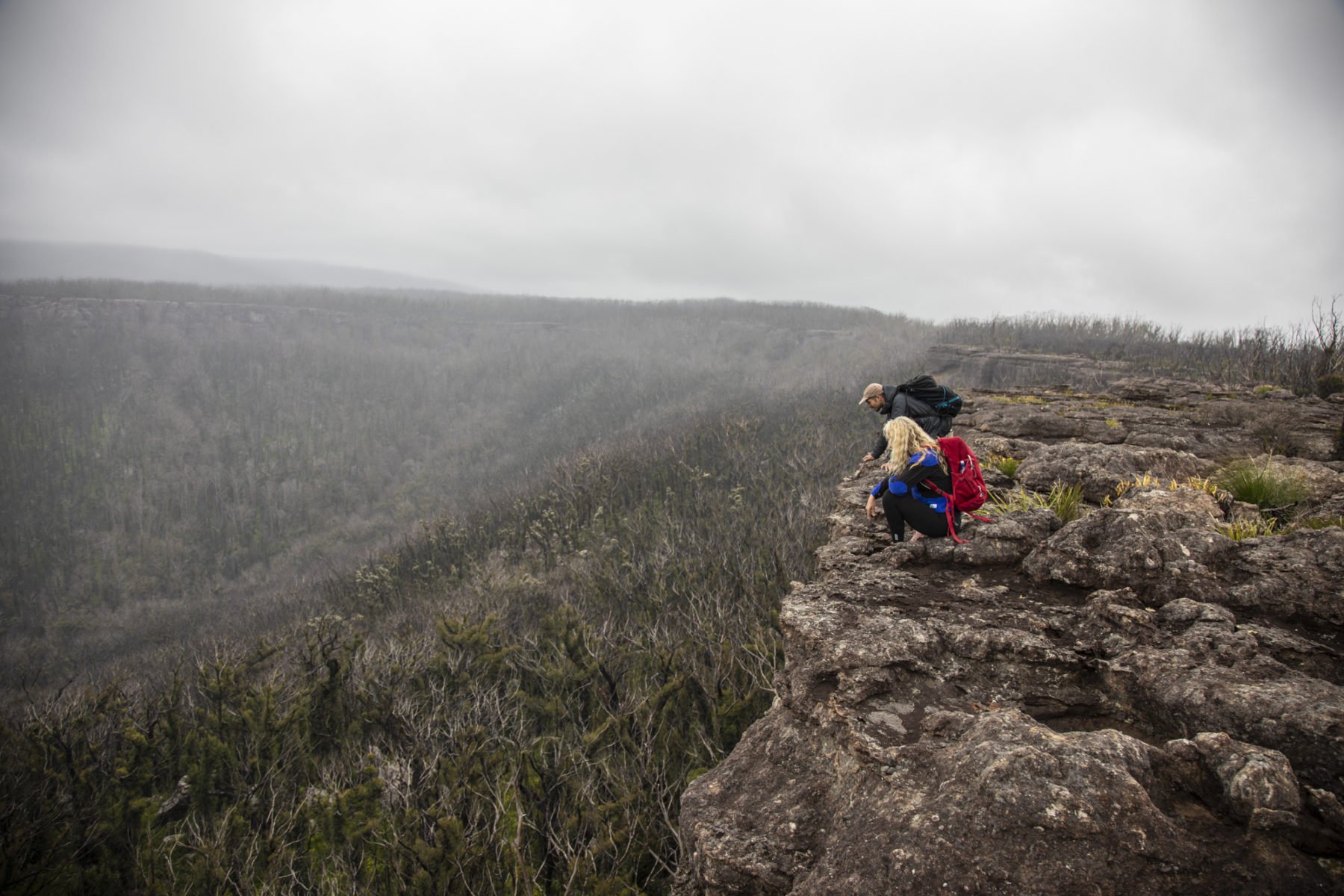
The next day is an incredible contrast: from the lush valley of the Shoalhaven River, we are up on the fire-scorched plateau of the Budawangs mountain range, inland from Milton (30 minutes’ drive south of Huskisson), tailing Chris Zinon of Big Nature Adventures along a bushwalking track. This country, near the borders of Budawang and Morton national parks, is rugged, and up here away from the green coastal valley we’d passed through, it seems even more so with a lot more of the region’s prolific sandstone exposed after the bushfires of December 2019/January 2020. Looking at the regrowth, you’d think it had gone ‘okay’ through the fire. That is, until you see the blackened banksia, and scorched soil.
If there’s any good in the bad ‘news’, it is that we get to see a lot more of the Shoalhaven landscape than usual, with it denuded of vegetation. And it’s a belting view from our final viewpoint looking over the twisting valleys that mark the routes of a number of waterways, including the Clyde River. Further, The Castle – a bushwalker’s favourite – can be seen, along with other peaks.
The Shoalhaven: where there’s never enough time
It’s the final morning. I have not long returned from a swim in Moona Moona Creek, right across the road from our Bay Blu apartment, and am now sitting alone at the back of the Jervis Bay Wild cruiser, enjoying the view of the bay’s striking green/blue water. It’s the end of a huge week and I am still trying to get my head around the sheer amount of adventure, fun, good food, great people and amazing locations we’ve experienced and the chance to reconnect after too long in the city.
Breaking from my thoughts is a shout when we reach the incredible cliffs and rock-stacks of Point Perpendicular, on the bay’s north-eastern side. Soon after, we’re joined by a bunch of marine comedians – Jervis Bay’s resident dolphin pod – with their frolicking and surfing of the boat’s bow wave. That’s brilliant, but it’s their natural, knowing smile that catches my attention most; it’s as if they’re laughing at just how lucky they are to live in this spectacular region. And I can’t really blame them for that; I’d be laughing, too.
The Shoalhaven Fact File
Getting there: The Shoalhaven region is about two hours from Sydney, via Princes Highway, and two hours from Canberra
Accommodation: There are plenty of accommodation options in the Jervis Bay area, ranging from caravan parks to apartments to holiday house rentals. Aus Geo ADVENTURE stayed at the Bay Blu Apartments, booked via Jervis Bay Holiday Rentals.
See www.jervisbayrentals.com.au
Kayaking: Jervis Bay Kayak and Paddle Sports offers a range of tours and lessons, from sit-on-top tours to sea kayak adventures. It also offers sea kayak and SUP tuition, and gear hire. See www.jervisbaykayaks.com.au
Cultural tours: Djiriba Waagura offers the two tours, Timbery Tour (as featured in this story) that runs for two hours, and Waraigala Badha in Nowra as well as other short tours, plus cultural camps. See www.djiribawaagura.com
Freediving: Woebegone Freedive offers courses on freediving in the waters of Jervis Bay. It also has guided beach- and boat-based snorkelling adventures, kids’ courses and private tuition. See www.woebegone.com.au
Climbing: For excellent climbing tuition, Rob Crow of Climb Nowra is the go-to. Rob knows all the crags exceptionally well. See www.climbnowra.com
SUP: SUP With George offers eight different SUP tours, as well as SUP, kayak, bike, boat and fishing gear hire. If you want to learn this activity, George and his instructors will have you on the water before you know it. See www.supwithgeorge.com.au
Bushwalking: For bushwalking in the area’s national parks, give Chris from Big Nature Adventure a shout. See www.bignatureadventures.com
Food: Huskisson has a number of eateries, including the Kanpai Japanese Restaurant, the Huskisson Hotel, as well as cool cafes, such as Pilgrims, 5 Little Pigs and Salty Joe’s.
More info: For all things Shoalhaven, the excellent www.shoalhaven.com website is an absolute must for planning itineraries, finding accommodation, the latest news on festivals and more.


